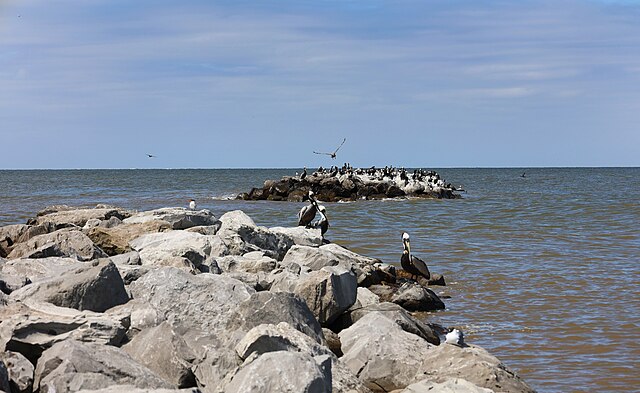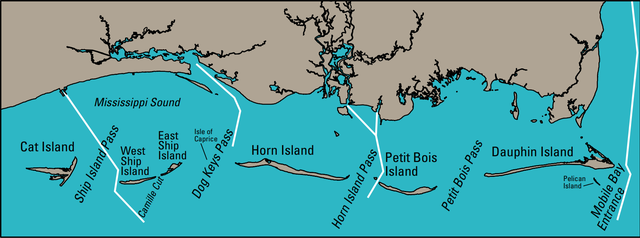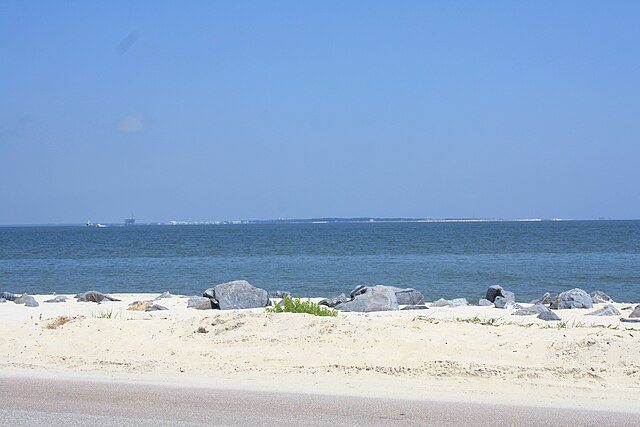Understanding Dauphin Island’s Unique Climate
Dauphin Island sits like a natural sentinel at the mouth of Mobile Bay, where the Gulf of Mexico meets Alabama’s coastline. This barrier island enjoys a subtropical climate that’s influenced by both the warm Gulf waters and the continental weather systems that sweep across the southeastern United States.
What makes Dauphin Island’s weather so special? It’s all about location, location, location. The surrounding Gulf waters act like a massive thermal regulator, keeping temperatures more moderate than you’d find inland. This means cooler summers and warmer winters compared to cities just a few miles away from the coast.
The island experiences high humidity year-round, which is typical for Gulf Coast locations. This moisture comes from the constant evaporation from the surrounding waters, creating that distinctive “beach air” feeling that many visitors love. However, this same humidity can make temperatures feel more intense than they actually are.
Seasonal Weather Patterns on Dauphin Island

Understanding the rhythm of Dauphin Island’s seasons helps you plan the perfect visit. Each season brings its own personality, from the gentle warmth of spring to the intense heat of summer, the pleasant relief of fall, and the surprising mildness of winter.
Spring Weather (March – May)
Spring on Dauphin Island is like nature’s gentle awakening. March temperatures typically range from the mid-50s to low 70s Fahrenheit, gradually warming as the season progresses. By May, you’re looking at comfortable highs in the upper 70s to low 80s.
This season brings some of the most pleasant weather of the year. The humidity hasn’t reached its summer peak yet, and afternoon thunderstorms are less frequent than in summer months. Spring is also prime time for bird migration, making it a fantastic season for nature enthusiasts.
Rain showers are common during spring, but they’re usually brief and refreshing rather than the intense downpours of summer. The Gulf waters are still cool from winter, so swimming might require a wetsuit for comfort, but beach activities are absolutely perfect.
Summer Heat and Humidity (June – August)
Summer on Dauphin Island is intense – there’s no sugar-coating it. Temperatures regularly climb into the upper 80s and low 90s, but the real story is the humidity. Heat index values can soar well above 100 degrees, making it feel like you’re walking through a steam room.
The good news? The Gulf breeze provides some relief, especially near the water. Afternoon thunderstorms are practically a daily occurrence, usually rolling in between 2 PM and 6 PM. These storms can be dramatic, with lightning, heavy rain, and strong winds, but they typically pass quickly and leave behind cooler, more comfortable conditions.
Summer is peak tourist season, and for good reason. The Gulf waters are warm and inviting, perfect for swimming, fishing, and water sports. Just remember to stay hydrated, seek shade during peak hours, and always have a backup indoor plan for those afternoon storms.
Fall Transitions (September – November)
Fall might just be Dauphin Island’s best-kept secret. September still feels like summer, but October and November bring some of the most beautiful weather of the year. Temperatures drop to comfortable levels – highs in the 70s and 80s with lower humidity.
The Gulf waters remain warm from the summer heat, making fall an excellent time for water activities. Hurricane season is winding down, though September and early October still require vigilance. The crowds thin out after Labor Day, giving you more space to enjoy the island’s natural beauty.
Fall is also migration season for birds, making it another prime time for wildlife watching. The weather is generally more stable, with fewer thunderstorms and more predictable conditions for outdoor activities.
Winter Mildness (December – February)
Winter on Dauphin Island is nothing like winter in most of the United States. Temperatures rarely drop below freezing, with typical highs in the 50s and 60s. The Gulf waters moderate the temperature, preventing the bitter cold that grips much of the country.
However, winter does bring its own challenges. Cold fronts can move through quickly, bringing strong winds and choppy seas. These fronts can drop temperatures 20-30 degrees in a matter of hours, so layered clothing is essential.
Winter is also the rainy season, with frequent cloud cover and precipitation. While it’s not the ideal beach weather, winter offers unique opportunities for storm watching, peaceful walks on empty beaches, and enjoying the island’s quieter side.
Hurricane Season: What You Need to Know

Hurricane season runs from June 1 through November 30, but Dauphin Island’s hurricane story is more nuanced than those dates suggest. Understanding the patterns and preparing accordingly is crucial for both residents and visitors.
Peak Hurricane Months
August, September, and October represent the peak of hurricane activity in the Gulf of Mexico. During these months, the Gulf waters are at their warmest, providing the energy that tropical systems need to intensify. Water temperatures often exceed 85 degrees Fahrenheit, creating ideal conditions for storm development.
The National Hurricane Center tracks an average of 12 named storms per year in the Atlantic basin, with about half of those affecting the Gulf Coast. However, numbers can vary dramatically from year to year. Some seasons see minimal activity, while others bring multiple major hurricanes.
Historical Hurricane Impact
Dauphin Island has weathered numerous significant storms throughout its history. Hurricane Katrina in 2005 brought devastating storm surge and winds, fundamentally changing parts of the island’s landscape. More recently, Hurricane Sally in 2020 caused significant damage with its slow-moving, rain-heavy approach.
These storms serve as reminders that while Dauphin Island’s weather is generally pleasant, the Gulf Coast’s hurricane risk is real. The island’s low elevation and barrier island status make it particularly vulnerable to storm surge, which is often more dangerous than the wind itself.
Preparation and Safety Tips
If you’re planning to visit during hurricane season, stay informed about tropical weather developments. Modern forecasting gives us several days’ notice of potential impacts, allowing time for evacuation if necessary.
Keep emergency supplies ready: water, non-perishable food, flashlights, batteries, and a battery-powered radio. Have an evacuation plan and know the routes off the island. Most importantly, never ignore evacuation orders – they’re issued for your safety.
Best Times to Visit Dauphin Island
Choosing the right time to visit Dauphin Island depends on what you want to do and your tolerance for heat, humidity, and crowds. Each season offers different advantages and experiences.
Beach Weather Considerations
For classic beach weather, late spring through early fall offers the best conditions. May through October provides warm Gulf waters and plenty of sunshine. However, this period also coincides with hurricane season and peak tourist crowds.
Summer brings the warmest water temperatures and longest days, but also the most intense heat and humidity. If you don’t mind the heat and afternoon thunderstorms, summer offers the full Gulf Coast experience with lively beach scenes and active nightlife.
Fishing and Water Activities
Fishing enthusiasts will find different opportunities throughout the year. Spring and fall offer some of the best fishing conditions, with comfortable temperatures and active fish populations. Summer fishing is excellent but requires early morning or evening trips to avoid the heat.
Winter fishing can be surprisingly productive, especially for species like redfish and speckled trout that remain active in cooler waters. The key is having the right gear and being prepared for changing weather conditions.
Bird Watching and Nature Activities
Dauphin Island is a critical stopover point for migrating birds, making spring and fall prime times for bird watching. The island’s Audubon Bird Sanctuary attracts hundreds of species during migration periods.
April and May bring the spring migration, while September and October offer fall migration viewing. These periods combine excellent weather with incredible wildlife viewing opportunities, making them ideal for nature enthusiasts.
Daily Weather Patterns and Microclimates

Understanding Dauphin Island’s daily weather rhythms helps you plan activities and stay comfortable throughout your visit.
Morning vs. Afternoon Conditions
Mornings on Dauphin Island typically start calm and pleasant. Temperatures are at their coolest, humidity feels more manageable, and winds are generally light. This makes morning the ideal time for beach walks, fishing, and outdoor photography.
As the day progresses, heating from the sun creates thermal differences between land and water. This leads to the development of sea breezes, which provide welcome relief but can also trigger afternoon thunderstorms. By mid-afternoon, especially in summer, conditions can become quite intense.
Coastal vs. Inland Variations
Even on a small barrier island like Dauphin Island, microclimates exist. Areas right along the Gulf shoreline benefit from constant breezes and are typically a few degrees cooler than inland areas. The bay side of the island tends to be more sheltered but also more humid.
Vegetation and development patterns also create microclimates. Heavily wooded areas provide shade and cooler conditions, while open beaches and paved areas can become significantly hotter during peak sun hours.
Weather Forecasting for Dauphin Island
Accurate weather forecasting is crucial for planning activities and staying safe on Dauphin Island. The dynamic nature of coastal weather makes reliable forecasting sources essential.
Reliable Weather Sources
The National Weather Service office in Mobile provides the most accurate forecasts for Dauphin Island. Their marine forecasts are particularly valuable for water activities and include information about wave heights, wind speeds, and small craft advisories.
Local television meteorologists also provide excellent coverage, with many having decades of experience forecasting Gulf Coast weather. They understand the local patterns and can provide insights that national services might miss.
Mobile Apps and Websites
Several mobile apps provide real-time weather data specifically useful for coastal areas. Radar apps show precipitation patterns, while marine weather apps provide wind, wave, and tide information. Weather Underground offers hyperlocal forecasting that can be particularly useful for Dauphin Island.
Social media groups and local Facebook pages often share real-time weather observations and photos, providing ground-truth information about current conditions on the island.
What to Pack for Different Seasons
Packing appropriately for Dauphin Island’s weather ensures comfort and safety throughout your visit.
Essential Summer Gear
Summer packing requires preparation for intense heat, humidity, and sudden thunderstorms. Lightweight, breathable clothing in light colors reflects heat and allows air circulation. Cotton and linen fabrics work well, though moisture-wicking synthetics can be more comfortable for active pursuits.
Sun protection is crucial: high-SPF sunscreen, wide-brimmed hats, and UV-protective clothing. The Gulf’s reflection intensifies sun exposure, making protection even more important than usual. Don’t forget quality sunglasses and consider a beach umbrella for extended outdoor time.
Rain gear is essential during summer months. A light rain jacket or poncho protects against sudden downpours, while waterproof bags keep electronics and important items dry. Flip-flops or water shoes are practical for wet conditions.
Winter Comfort Items
Winter packing requires layers for changeable conditions. A warm jacket or windbreaker is essential for cold fronts, while lighter layers work for milder days. Waterproof outer layers protect against winter’s frequent rain.
Closed-toe shoes become more important in winter, both for warmth and protection from cooler sand and shells. Long pants and long-sleeved shirts provide comfort during cooler temperatures and windy conditions.
Year-Round Necessities
Regardless of season, certain items are always useful on Dauphin Island. Insect repellent protects against mosquitoes and other biting insects that thrive in the coastal environment. A first-aid kit addresses minor cuts and scrapes from shells and coral.
Reusable water bottles help maintain hydration in the humid climate, while waterproof phone cases protect electronics from sand and moisture. A good beach bag keeps essentials organized and easily accessible.
Conclusion
Dauphin Island’s weather is as dynamic and captivating as the island itself. From the gentle warmth of spring mornings to the dramatic afternoon thunderstorms of summer, from the pleasant relief of fall to the surprising mildness of winter, each season brings its own unique character to this Gulf Coast paradise.
Understanding these weather patterns helps you make the most of your Dauphin Island experience. Whether you’re seeking the perfect beach day, planning a fishing expedition, or hoping to witness the incredible bird migrations, timing your visit with the weather can make all the difference.
Remember that coastal weather can change quickly, so stay informed, pack appropriately, and always prioritize safety – especially during hurricane season. With proper preparation and realistic expectations, Dauphin Island’s weather becomes part of the adventure, adding richness and authenticity to your Gulf Coast experience.
The island’s subtropical climate, moderated by the Gulf’s warm waters, creates a year-round destination with something special to offer in every season. Embrace the humidity, respect the storms, and enjoy the unique weather patterns that make Dauphin Island a truly special place on Alabama’s coast.
Frequently Asked Questions
Q: What’s the best month to visit Dauphin Island for good weather?
A: October is often considered the best month, offering warm temperatures (70s-80s), lower humidity, warm Gulf waters, and minimal hurricane risk. May is another excellent choice with pleasant spring conditions and fewer crowds.
Q: How often do hurricanes actually hit Dauphin Island?
A: While hurricane season runs June through November, direct hits are relatively rare. The island experiences tropical storm or hurricane conditions every few years on average, but modern forecasting provides adequate warning for preparation or evacuation.
Q: Is it too hot to visit Dauphin Island in summer?
A: Summer is hot and humid, with heat index values often exceeding 100°F. However, Gulf breezes, afternoon thunderstorms, and warm water for swimming make it manageable. Early morning and evening activities are most comfortable.
Q: What should I expect for winter weather on Dauphin Island?
A: Winter is mild compared to most U.S. locations, with highs typically in the 50s and 60s. Expect frequent rain, occasional cold fronts with strong winds, and generally cloudy conditions. Freezing temperatures are rare but possible.
Q: How accurate are weather forecasts for Dauphin Island?
A: Coastal weather can be challenging to predict, but the National Weather Service provides reliable forecasts. Conditions can change quickly, especially regarding afternoon thunderstorms, so check forecasts frequently and be prepared for sudden changes.

